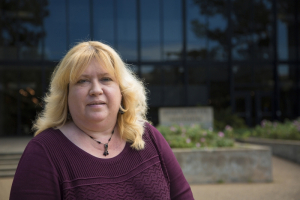Tuberculosis granulomas, which are collections of immune cells and bacteria, can aggregate in the human lung when people inhale Mycobacterium tuberculosis, the harmful bacteria that cause tuberculosis. Immune responders, such as T-cells and macrophages, attempt to form granulomas by surrounding and containing the bacteria.
Cheryl Sershen, post-doctoral research scientist in the May Multiscale Immunobiology Design Algorithms and Simulation (MIDAS) Lab in the biomedical engineering department at UH Cullen College of Engineering, seeks to develop a better understanding of the host-pathogen interactions involved in tuberculosis infections using computer simulations. The computational biologist modeled the effects of oxygen on formation of tuberculosis granuloma in the human lung.
She recently won a $300 travel award to attend the IEEE Engineering in Medicine and Biology Society’s 2014 international conference in Chicago, Illinois to present her four-page paper, “A Method for Modeling Oxygen Diffusion in a Multi-scale Model with Application to Host-Pathogen Interaction.” Co-authors on the paper include Steven J. Plimpton, distinguished member of the technical staff at Sandia National Laboratory, and Elebeoba E. May, senior author and principal investigator in the MIDAS lab at the Cullen College of Engineering.
“The role of oxygen in granuloma formation has been studied experimentally, but never to our knowledge with computer simulations,” Sershen said. “The models with oxygen dynamics depict better the developmental paths followed by the infection.”
Sershen’s computer simulations show the progression of the infection over hundreds of days. Roughly one-third of the world’s population is infected with tuberculosis. Two-thirds of healthy people infected with tuberculosis clear the infection, and the others either contain or disseminate the bacteria. The infection disseminates when recruitment of immune cells cannot keep pace with reproduction of bacteria, which consequently spread to the rest of the lung. The bacteria are more likely to disseminate in people with compromised immune systems, like those with HIV, emphysema or COPD, but oxygen levels also influence outcomes.
Immune cells and bacteria consume oxygen in the lung tissue, so oxygen in lung tissue is depleted as granulomas form, Sershen said. In some cases, oxygen levels might drop below two percent, which is a state called hypoxia. In that environment, bacteria may potentially enter a stage of non-replicating persistence, which means that bacterial replication is halted, though bacteria are still metabolically active. The infection becomes latent, which allows immune cells to contain the bacteria so that the disease does not become full-blown.
“So that’s an effect of oxygen, and that hasn’t been computationally explored yet,” Sershen said. “Containment is the next best thing to clearing the infection because physicians can treat the latent tuberculosis infection with a combination of chemotherapeutic agents.”
By capturing, analyzing and optimizing data, the model can computationally produce desired outcomes such as clearance or containment of tuberculosis and help identify infection dynamics and mechanisms so that drug targets might be identified. Also, the researchers can use the model to identify key drivers of infection by characterizing specific epidemiological groups, such as HIV/TB co-infection, and by culling data sets from medical literature.
Antibiotic or chemotherapeutic drugs may then target the significant infection drivers, or it may be necessary to refrain from treatments that have already been identified to cause adverse effects. For example, it is known that a pro-inflammatory agent acts to suppress bacterial levels in latent TB infection, so administration of an anti-inflammatory drug is associated with re-activation of infection.
Tuberculosis is the leading cause of death in HIV patients, and ongoing research in May's MIDAS lab focuses on tuberculosis in patients with pre-existing conditions such as HIV, malnutrition, diabetes and COPD. Most people infected with tuberculosis live in developing countries. More than eight million people worldwide became ill with tuberculosis in 2012, and half a million of those infected were children, according to the World Health Organization website. That same year, one million people died from the disease, of which 75,000 were HIV-negative children. The number of cases in the United States has declined since its resurgence peak in 1992 with 9,600 cases reported in 2013, according to the Centers for Disease Control and Prevention website. In the U.S., tuberculosis caused approximately 500 deaths in 2011.
Working with May and Plimpton, Sershen is preparing a more comprehensive paper that explores the effects of oxygen on tuberculosis granuloma formation. The work is supported by grants from the Department of Defense’s Defense Threat Reduction Agency and the Department of Energy’s Sandia National Laboratory Directed Research and Development program.
